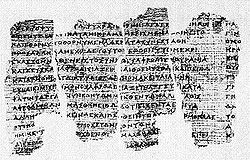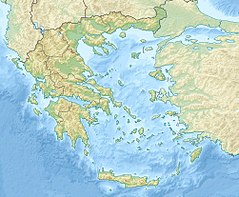
In Greek mythology, Nyx is the goddess and personification of the night. In Hesiod's Theogony, she is the offspring of Chaos, and the mother of Aether and Hemera (Day) by Erebus (Darkness). By herself, she produces a brood of children which are personifications of primarily negative forces. She features in a number of early cosmogonies, which place her as one of the first deities to exist. In the works of poets and playwrights, she lives at the ends of the Earth, and is often described as a black-robed goddess who drives through the sky in a chariot pulled by horses. In the Iliad, Homer relates that even Zeus fears to displease her.
Posidippus of Pella was an Ancient Greek epigrammatic poet.

Pherecydes of Syros was an Ancient Greek mythographer and proto-philosopher from the island of Syros. Little is known about his life and death. Some ancient testimonies counted Pherecydes among the Seven Sages of Greece, although he is generally believed to have lived in the generation after them. Others claim he may have been a teacher of Pythagoras, a student of Pittacus, or a well-traveled autodidact who had studied secret Phoenician books.

The "Magdalen" papyrus was purchased in Luxor, Egypt in 1901 by Reverend Charles Bousfield Huleatt (1863–1908), who identified the Greek fragments as portions of the Gospel of Matthew and presented them to Magdalen College, Oxford, where they are catalogued as P. Magdalen Greek 17 from which they acquired their name. When the fragments were published by Colin Henderson Roberts in 1953, illustrated with a photograph, the hand was characterized as "an early predecessor of the so-called 'Biblical Uncial'" which began to emerge towards the end of the 2nd century. The uncial style is epitomised by the later biblical Codex Vaticanus and Codex Sinaiticus. Comparative paleographical analysis has remained the methodological key for dating the manuscript, but there is no consensus on the dating of the papyrus. Estimates have ranged from the 1st century to the 4th century AD.

Orphism is the name given to a set of religious beliefs and practices originating in the ancient Greek and Hellenistic world, associated with literature ascribed to the mythical poet Orpheus, who descended into the Greek underworld and returned. This type of journey is called a katabasis and is the basis of several hero worships and journeys. Orphics revered Dionysus and Persephone. Orphism has been described as a reform of the earlier Dionysian religion, involving a re-interpretation or re-reading of the myth of Dionysus and a re-ordering of Hesiod's Theogony, based in part on pre-Socratic philosophy.

In Greek mythology, Aether, Æther, Aither, or Ether is the personification of the bright upper sky. According to Hesiod, he was the son of Erebus (Darkness) and Nyx (Night), and the brother of Hemera (Day). In Orphic cosmogony Aether was the offspring of Chronos (Time), and the brother of Chaos and Erebus.

The Catalogue of Women —also known as the Ehoiai —is a fragmentary Greek epic poem that was attributed to Hesiod during antiquity. The "women" of the title were in fact heroines, many of whom lay with gods, bearing the heroes of Greek mythology to both divine and mortal paramours. In contrast with the focus upon narrative in the Homeric Iliad and Odyssey, the Catalogue was structured around a vast system of genealogies stemming from these unions and, in M. L. West's appraisal, covered "the whole of the heroic age." Through the course of the poem's five books, these family trees were embellished with stories involving many of their members, and so the poem amounted to a compendium of heroic mythology in much the same way that the Hesiodic Theogony presents a systematic account of the Greek pantheon built upon divine genealogies.
The Cologne Mani-Codex is a minute parchment codex, dated on paleographical evidence to the fifth century CE, found near Asyut, Egypt; it contains a Greek text describing the life of Mani, the founder of the religion Manichaeism.

Martin Litchfield West, was a British philologist and classical scholar. In recognition of his contribution to scholarship, he was awarded the Order of Merit in 2014.

Artemidorus of Ephesus was a Greek geographer, who flourished around 100 BC. His work in eleven books is often quoted by Strabo. What is thought to be a possible fragment of his work is considered by some scholars to be a forgery.

Totenpass is a German term sometimes used for inscribed tablets or metal leaves found in burials primarily of those presumed to be initiates into Orphic, Dionysiac, and some ancient Egyptian and Semitic religions. The term may be understood in English as a "passport for the dead". The so-called Orphic gold tablets are perhaps the best-known example.
Papyrus 82, designated by 𝔓82, is an early copy of the New Testament in Greek. It is a papyrus manuscript of the Gospel of Luke. The surviving texts of Luke are verses 7:32-34,37-38. The manuscript paleographically had been assigned to the 4th century.

In Greek mythology, Orpheus was a Thracian bard, legendary musician and prophet. He was also a renowned poet and, according to the legend, travelled with Jason and the Argonauts in search of the Golden Fleece, and even descended into the underworld of Hades, to recover his lost wife Eurydice.

The so-called Alcestis Barcinonensis is a mythological poem of at least 124 Latin hexameters on the story of Alcestis dying for the sake of her husband Admetus, following by and large the play by Euripides. The poem has been written on four papyrus leaves dated to the second half of the fourth century on account of the handwriting, an early half-uncial with cursive elements, and inserted into a codex mixtus at some later point in time. The editio princeps has been published by the Catalan priest and papyrologist Ramon Roca-Puig on 18 October 1982. The papyrus leaves are now in the possession of the foundation Sant Lluc Evangelista founded by Roca-Puig and located in Barcelona.

Papyrus Oxyrhynchus 7 is a papyrus found at Oxyrhynchus in Egypt. It was discovered by Bernard Pyne Grenfell and Arthur Surridge Hunt in 1897, and published in 1898. It dates to the third century AD. The papyrus is now in the British Library.
Papyrus Oxyrhynchus 85 is part of a series of declarations by various guilds of workmen, written in Greek. The manuscript was written on papyrus in the form of a sheet. It was discovered in Oxyrhynchus. The document was written on 26 November 338. Currently it is housed in the Department of Manuscripts of the British Museum (760) in London.
Richard Charles Murray Janko is an Anglo-American classical scholar and the Gerald F. Else Distinguished University Professor of Classical Studies at the University of Michigan.
Papyrus Oxyrhynchus 842 is a papyrus manuscript, written in Ancient Greek, discovered during the 1906 excavations in Oxyrhynchus in modern Egypt by Bernard Pyne Grenfell and Arthur Surridge Hunt. It contains a history of classic Greece for the years 396-395 BCE. Along with PSI XII 1304, it makes up the Hellenica Oxyrhynchia.

The Tithonus poem, also known as the old age poem or the New Sappho, is a poem by the archaic Greek poet Sappho. It is part of fragment 58 in Eva-Maria Voigt's edition of Sappho. The poem is from Book IV of the Alexandrian edition of Sappho's poetry. It was first published in 1922, after a fragment of papyrus on which it was partially preserved was discovered at Oxyrhynchus in Egypt; further papyrus fragments published in 2004 almost completed the poem, drawing international media attention. One of very few substantially complete works by Sappho, it deals with the effects of ageing. There is scholarly debate about where the poem ends, as four lines previously thought to have been part of the poem are not found on the 2004 papyrus.
The Philinna Papyrus is part of a collection of ancient Greek spells written in hexameter verse. Three spells are partially preserved on the papyrus. One is a cure for headache, one probably for a skin condition, and the purpose of the third spell is uncertain. Two fragments of the papyrus survive, in the collections of the Morgan Library & Museum, New York, and the Berlin State Museums.















